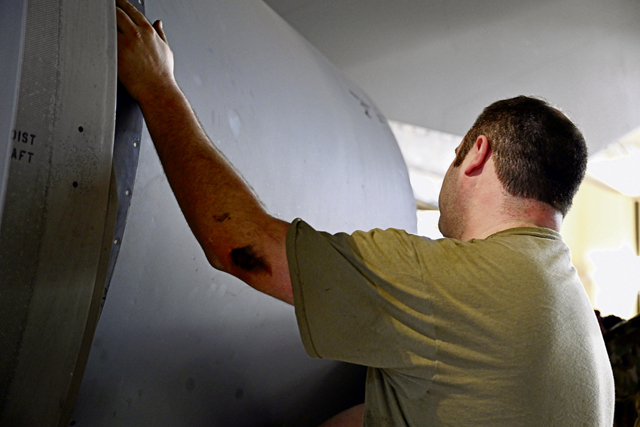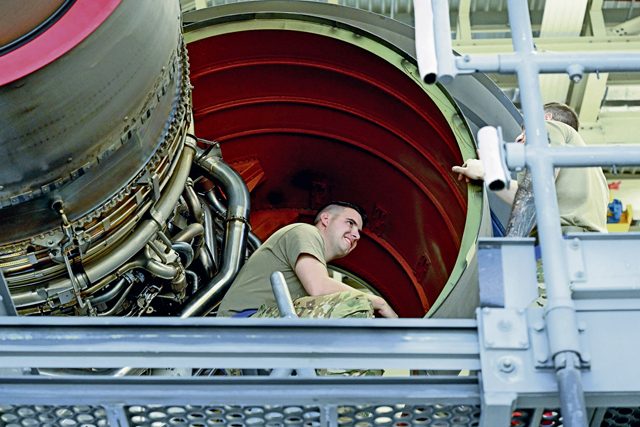Maintainers completed the first overseas C-5M Super Galaxy engine change at Ramstein AB, Dec. 6.
The 13-day task to change the largest U.S. Air Force aircraft engine was a team effort and took a diverse group of eight maintainers from various duty locations, specialties and backgrounds.
The team included a Regional Training Center instructor from the 521st Air Mobility Operations Wing, headquartered at Ramstein AB, an engine technician from the 52nd Maintenance Squadron, Spangdahlem Air Base, and six members of the Maintenance Recovery Team from Dover Air Force Base, Delaware.

The team consisted of three flying crew chiefs, two jet technicians and a quality assurance supervisor.
Additional personnel from the 721st Aircraft Maintenance Squadron, located at Ramstein AB and hosts for the operation, also performed roles as spotters, observers and alternates, when needed.
Tech. Sgt. Michael Cain, 521st AMOW, RTC, credits the group’s diversity in skills as a key contributor to the success of the engine change. Cain’s background on other airframes was his strength.
“Each member brought their own experiences and thoughts on how to attack this engine replacement,” he said. “I worked the KC-10 [Extender] for years and the C-5M engine is just an updated version, so I was able to compare a lot of similarities in the processes.”
Along with Cain’s perspective on other airframes, the MRT members with more experience on the C-5M taught him about the engine and explained how all the systems tied together.

“I personally love to turn wrenches and to do that on such a rare project was a great experience,” Cain added.
Diversity wasn’t the team’s only strength. To lower and raise the original and new engines, the Airmen used an unpowered chains and crank system, meaning the team relied on thorough communication and muscle power to successfully replace the approximately 13,000-pound engine.
Cain augmented an MRT of fellow dedicated maintainers from Dover AFB, the home station for the aircraft.
Airman 1st Class Carsen Segna, the most junior airmen on the team, provided the preponderance prior experience on C-5M engine changes.
Pointing to the large, 14-foot engine, Segna reflected on his experience with engine changes stating the task is, “kind of daunting at first,” and added, “once you get into the motions of everything it just falls into place.”
Segna went on to say that this particular engine change had, “most definitely been the easiest and smoothest,” and attributed this to the wealth of experience and knowledge within the team.
This was the third operational engine change on the C-5M since the C-5 Reliability Enhancement and Re-engining Program replaced engines, landing gear and other structural elements.
During RERP, the C-5 aircraft engines were upgraded from four General Electric TF-39 engines to General Electric CF6-80C2-L1F (F138) commercial engines. The update increased thrust and climb rate, decreased take-off roll, and ultimately allowed more cargo to be carried over longer distances. With new engines and other system upgrades, RERP modified C-5A/B/Cs became C-5M Super Galaxies. The entire C-5 fleet completed the upgrade in fiscal year 2018.
Considering the freezing temperatures of a European winter, the work took place in the largest aircraft hangar outside the continental U.S., which is owned and operated by the 521st AMOW’s 721st AMXS.
The same hangar was recently transformed into an international terminal in support of the Afghanistan noncombatant evacuation operation in fall 2021, and was then used to host the Kaiserslautern Military Community’s Annual Ramstein Bazaar in mid-October.
The 521st AMOW is an Air Mobility Command wing and has en route nodes strategically located across Europe, Africa and the Middle East to support strategic airlift and rapid global mobility with aircraft maintenance, aerial port operations, command and control, aeromedical evacuation and expeditionary aircrew support in the regions.


